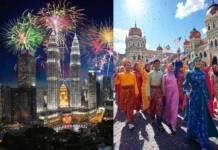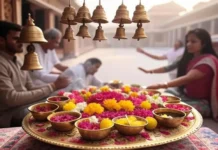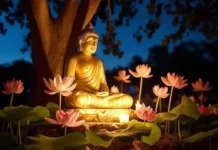Prayagraj, formerly known as Allahabad, holds immense spiritual significance as the Triveni Sangam, where the holy rivers Ganga, Yamuna, and the mythical Saraswati meet. This makes the city a top destination for millions of pilgrims and spiritual seekers, especially during the Mahakumbh Mela in 2025. The city, with its ancient temples, historical landmarks, and rich cultural heritage, offers a unique blend of spirituality, history, and culture.
The Prayagraj Mahakumbh 2025 is more than just a religious event. It’s a grand gathering of faith, where people from all walks of life come together to bathe in the sacred waters of the Sangam, participate in spiritual discourses, and experience the power of collective devotion. Whether you’re a spiritual seeker or a traveler exploring India’s religious traditions, Prayagraj Mahakumbh 2025 offers an experience you won’t forget.
In this guide, we’ll cover the key attractions, important dates, rituals, and practical tips for attending the Prayagraj Mahakumbh 2025.
Key Highlights of Prayagraj Mahakumbh 2025
| Aspect | Details |
|---|---|
| Location | Prayagraj, Uttar Pradesh, India, at the sacred Triveni Sangam where the Ganga, Yamuna, and Saraswati rivers meet. |
| Event Dates | The Mahakumbh begins with the Paush Purnima Snan on 13th January 2025 and continues with other significant bathing dates such as Makar Sankranti (14th January), Mauni Amavasya (29th January), and more. |
| Key Events | Shahi Snan (Royal Bath), religious processions, spiritual talks, cultural performances, and community services. |
| Estimated Visitors | Millions of devotees, saints, and tourists gather for the grand event. |
| Significance | The Mahakumbh, which occurs once every 12 years, is one of the largest spiritual gatherings in the world. It’s believed that bathing in the Sangam cleanses the soul and liberates one from the cycle of rebirth. |
Important Dates for Prayagraj Mahakumbh 2025
The Prayagraj Mahakumbh 2025 will span over several weeks, with each day holding its own significance. Here are the key dates you should keep in mind:
- Paush Purnima – 13th January 2025: Marks the unofficial start of the Mahakumbh with the first holy dip of the event.
- Makar Sankranti – 14th January 2025: A day marked by charity and community giving, as pilgrims offer donations.
- Mauni Amavasya – 29th January 2025: Known as the most auspicious day for taking a dip in the Sangam, drawing the largest crowd.
- Basant Panchami – 3rd February 2025: Celebrates the arrival of Goddess Saraswati, the goddess of knowledge.
- Maghi Purnima – 12th February 2025: A day for honoring the Hindu deity Gandharva, believed to descend from the heavens.
- Maha Shivaratri – 26th February 2025: The final holy bath for the Kalpvasis (pilgrims who stay for the entire duration of the Kumbh).
Each of these days will be filled with sacred rituals, processions, and spiritual discourses that make this gathering an unforgettable experience.
History and Origin of Prayagraj Mahakumbh
The Prayagraj Mahakumbh Mela is one of the largest and most significant religious gatherings in the world, held every 12 years at the Triveni Sangam in Prayagraj (formerly Allahabad). The Mela is a confluence of three holy rivers — Ganga, Yamuna, and the mythical Saraswati. It is believed to have begun thousands of years ago, with Hindu mythology linking it to the story of the Samudra Manthan (churning of the ocean), where drops of nectar (amrit) fell at four places, including Prayagraj. These sacred spots are known as the Kumbh Mela sites, and each time the festival is held, millions of pilgrims gather to take a ritual dip in the holy rivers to cleanse their souls.
The Mahakumbh is distinguished by its immense scale, with the 2025 edition expected to draw millions of devotees and tourists from around the globe. This tradition, rooted deeply in Indian spiritual practices, dates back to the ancient times, and over the centuries, it has grown into a cultural and religious phenomenon that represents the eternal connection between faith and the divine.
Rituals and Ceremonies During the Prayagraj Mahakumbh
1. Shahi Snan (Royal Bath)
The Shahi Snan, or Royal Bath, is the centerpiece of the Prayagraj Mahakumbh. On specific auspicious days, saints and their followers from various Akharas (religious orders) lead the ceremonial processions to the Sangam. The royal bath is a symbolic and sacred ritual believed to purify the soul and bring divine blessings.
2. Kalpvasis and Spiritual Practices
Pilgrims who choose to stay for the duration of the Mahakumbh engage in intense spiritual practices known as Kalpvas. This period involves a commitment to prayer, meditation, and living a disciplined life. For those seeking spiritual liberation, Kalpvas is a deeply transformative experience.
3. Cultural Performances and Processions
While the Mahakumbh is a deeply spiritual event, it is also a showcase of India’s rich cultural heritage. You will witness traditional music, dance, and art forms as well as processions featuring Naga Sadhus (ascetic monks) and other holy men. These processions add to the grandeur of the festival, making it a celebration of both religion and culture.
Top Places to Visit in Prayagraj
In addition to the Mahakumbh Mela, Prayagraj is home to several key attractions that add to its spiritual and historical charm. Here are some of the top places to visit while you’re in the city:
1. Triveni Sangam
The most sacred site in Prayagraj, the Triveni Sangam is the confluence of the Ganga, Yamuna, and Saraswati rivers. It is here that millions of pilgrims come to bathe during the Mahakumbh Mela. The riverbanks are also ideal for meditation and reflection.
2. Temples
- Hanuman Mandir: A prominent temple dedicated to Lord Hanuman, one of the most revered deities in Hinduism.
- Alopi Devi Mandir: A sacred temple believed to be the final resting place of Alopi Devi.
- Mankameshwar Temple: A well-known temple dedicated to Lord Shiva, often visited by those seeking spiritual blessings.
3. Historical Landmarks
- Ashoka Pillar: An ancient historical monument from the Mauryan Empire, showcasing the rich heritage of India.
- Swaraj Bhawan: A colonial-era building, once the residence of the Nehru family, symbolizing India’s freedom struggle.
4. Colonial Architecture
The city boasts impressive colonial-era buildings such as the University of Allahabad and Prayagraj Railway Station, providing a glimpse into its historical past.
Travel Tips for Attending Prayagraj Mahakumbh 2025
If you’re planning to attend the Mahakumbh, here are some practical tips to ensure a safe and enjoyable visit:
1. Accommodation
Since the Mahakumbh attracts millions of visitors, it’s crucial to book your accommodation well in advance. There are a variety of options, from simple tents and temporary camps to hotels and guesthouses.
2. What to Carry
Travel light and carry only essential items like clothes, toiletries, medications (if needed), and a valid ID. Avoid carrying valuables, as they might get lost in the crowd.
3. Stay Safe
Be mindful of your belongings and always stay within the designated areas marked by the event organizers. Follow the instructions given by the Mela Administration and local authorities.
4. Health and Safety
Stay hydrated, wear comfortable clothes, and be cautious about where you eat. Only consume food from authorized vendors to avoid health issues.
5. Environmental Responsibility
Avoid using plastic bags, and always dispose of waste in the designated bins. Do not pollute the river or the surrounding areas with soaps, detergents, or flowers.
Importance and Objectives of Prayagraj Mahakumbh 2025
The Prayagraj Mahakumbh Mela is a vital event for millions of Hindus, drawing attention to the profound spiritual beliefs and rituals of India. Its importance can be understood in several ways:
- Spiritual Cleansing: Pilgrims believe that by bathing in the holy waters of the Triveni Sangam during the Mahakumbh, they cleanse themselves of sins and attain Moksha, or liberation from the cycle of rebirth.
- Unity and Faith: The event brings together people from diverse backgrounds, cultures, and regions, fostering a sense of unity through shared faith and devotion.
- Cultural Celebration: Beyond its spiritual significance, the Mahakumbh is a celebration of India’s rich cultural heritage, with sacred music, spiritual discourses, and processions of saints, mystics, and devotees filling the air with divine energy.
- Global Awareness: The Mahakumbh serves as a reminder of the strength of collective faith, making it a symbol of religious unity and tolerance for people across the world.
For those attending the Prayagraj Mahakumbh 2025, it is not only a religious journey but also an opportunity to witness the world’s largest spiritual gathering.
How Prayagraj Mahakumbh 2025 Is Celebrated
The Prayagraj Mahakumbh 2025 is celebrated through a series of spiritual, cultural, and social events, making it a truly unique and profound experience. Here are some ways people will observe this momentous event:
- Shahi Snan (Royal Bath): The highlight of the Mahakumbh is the Shahi Snan, or Royal Bath, which takes place on specific auspicious dates like Paush Purnima, Makar Sankranti, and Mauni Amavasya. On these days, millions of devotees gather to take a sacred dip in the Triveni Sangam, believing it purifies the soul and grants blessings. The processions of saints and Akharas (religious orders) leading the way to the holy rivers add to the grandeur of the event.
- Spiritual Discourses and Katha Sessions: Alongside the bathing rituals, spiritual talks, Bhajans, and Kirtans (devotional songs) are conducted by prominent saints, spiritual leaders, and religious scholars. These sessions provide attendees with profound insights into the spiritual significance of the Kumbh Mela and Hindu beliefs.
- Volunteer and Charity Work: During the Mahakumbh, a significant amount of social service takes place. Pilgrims, volunteers, and charitable organizations come together to provide free food, medical services, and water supply to millions of attendees. This displays the spirit of selfless service, which is deeply rooted in Indian culture.
- Cultural Programs: The Prayagraj Mahakumbh is not only about religion but also celebrates Indian culture. During the event, traditional dance and music performances are held, reflecting the diversity of Indian heritage. Local markets also thrive, offering various religious artifacts, food items, and cultural products.
- Kalpavasis and Sadhus: Thousands of pilgrims, known as Kalpavasis, stay at the Kumbh Mela site for the entire duration of the event, participating in daily rituals and meditative practices. They live a simple life devoted to prayer, fasting, and spiritual growth, making this part of the Mahakumbh an even more profound experience.
- Tourism and Pilgrimage: For visitors, the Mahakumbh is an incredible opportunity to explore Prayagraj’s temples, historical landmarks, and colonial architecture. The Triveni Sangam, Hanuman Mandir, and Mankameshwar Temple are key attractions, while historical sites like the Ashoka Pillar and Swaraj Bhawan provide a window into India’s past.
Interesting Facts about Prayagraj Mahakumbh 2025
- Largest Religious Gathering: The Prayagraj Mahakumbh is considered the world’s largest religious gathering, with an estimated 120 million visitors expected in 2025.
- Duration: While the Mahakumbh takes place every 12 years, it spans over a month, with specific important bathing dates drawing millions of pilgrims each year.
- The Mythical Connection: The significance of the Triveni Sangam comes from the Hindu belief that nectar (amrit) fell at four places, including Prayagraj, during the Samudra Manthan, making it a sacred site for purification.
- Shahi Snan Processions: The Shahi Snan is one of the most visually striking aspects of the Mahakumbh, with Naga sadhus (ascetic monks) and other religious leaders leading grand processions to the riverbanks.
- Global Participation: The Mahakumbh is not just a local event—it attracts pilgrims from all over the world, including from Nepal, Bangladesh, and even Western countries, seeking spiritual purification.
Conclusion: Experience the Divine at Prayagraj Mahakumbh 2025
The Prayagraj Mahakumbh 2025 is not just a religious event; it is a celebration of faith, unity, and culture. With its deeply rooted spiritual traditions, cultural performances, and the chance to witness one of the largest gatherings of humanity, it is an experience that will stay with you forever. Whether you come to pray, to learn, or simply to witness the grand spectacle, Prayagraj Mahakumbh 2025 will leave you spiritually enriched and profoundly inspired.
Mark your calendars and make sure to visit this sacred event. It promises to be an unforgettable journey through the heart of India’s spiritual and cultural heritage.





























